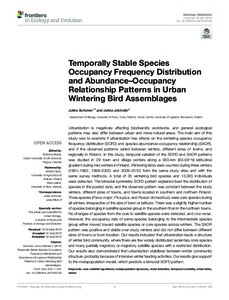Temporally stable species occupancy frequency distribution and abundance-occupancy relationship patterns in urban wintering bird assemblages
Suhonen J.; Jokimäki J.
https://urn.fi/URN:NBN:fi-fe2021042827111
Tiivistelmä
Urbanization is negatively affecting biodiversity worldwide and general ecological patterns may also differ between urban and more natural areas. The main aim of this study was to examine if urbanization has effects on the wintering species occupancy frequency distribution (SOFD) and species abundance-occupancy relationship (SAOR), and if the observed patterns varied between winters, different sizes of towns and regionally in Finland. In this study temporal variation of the SOFD and SAOR patterns were studied in 29 town and village centers along a 950 km (60-68° N) latitudinal gradient during mid-winters in Finland. Wintering bird were counted during three winters (1991-1992, 1999-2000, and 2009-2010) from the same study sites and with the same survey methods. A total of 35 wintering bird species and 13285 individuals were detected. The bimodal symmetric SOFD pattern explained best the distribution of species in the pooled data, and the observed pattern was constant between the study winters, different sized of towns and towns located in southern and northern Finland. Three species (Parus major, Pica pica and Passer domesticus) were core species during all winters, irrespective of the size of town or latitude. There was slightly higher number of species belonging in satellite species group in the southern than in the northern towns. No changes of species from the core- to satellite-species were detected, and vice versa. However, occupancy rate of some species belonging to the intermediate species group either moved towards satellite-species or core-species across winters. The SAOR pattern was positive and stable over study winters and did not differ between different sizes of towns or town location. Our results indicated that urbanization leads a structure of winter bird community, where there is few widely distributed sedentary core species and many partially migratory or migratory satellite species with a restricted distribution. Our results also demonstrated that urbanization stabilize between-winter community structure, probably because of intensive winter feeding activities. Our results give support to the meta-population model, which predicts a bimodal SOFD pattern. © 2019 Suhonen and Jokimäki.
Kokoelmat
- Rinnakkaistallenteet [27094]
